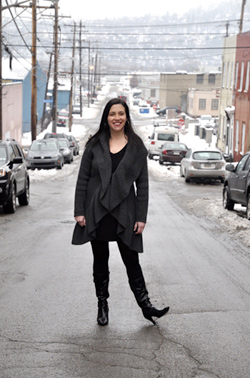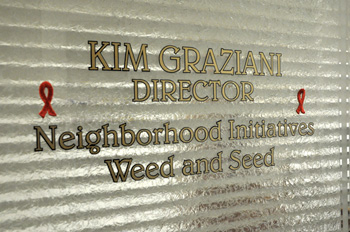 When she says Pittsburgh’s neighborhoods are its best selling point, Kim Graziani isn’t only justifying her existence. She’s telling her life story.
When she says Pittsburgh’s neighborhoods are its best selling point, Kim Graziani isn’t only justifying her existence. She’s telling her life story.
The director of the city’s Office of Neighborhood Initiatives grew up with a case of neighborhood envy after her family moved from a Bronx high-rise to to an isolated house in the middle of the Poconos woods and then a small town. Even at the age of 10, she missed the hustle and bustle of urban living and being part of a tight-knit community.
When she got to choose among any college in the state of PA, she chose the urban and cross-state University of Pittsburgh. While at Pitt (where she now teaches a class), Graziani started doing community volunteer work, culminating in a Mon Valley youth arts festival she conceived and organized.
Following graduation, New York City lured her back for a time. But after four years in Manhattan working in the nonprofit sector and a brief stint in Atlanta, she was back at Pitt for grad school in social work and public policy. “I just never really felt the sense of neighborhoods until I came to Pittsburgh,” she says.
On the side, she interned in Congressman Mike Doyle’s office, working with community development groups.
Graziani met Luke Ravenstahl seven years ago, when she was director of residential development for the Northside Leadership Conference and he was a city councilman for District 1, which includes several North Side neighborhoods. When Ravenstahl became mayor in 2006, he asked Graziani to head his new office of neighborhood programs.
Now Graziani can be found welcoming the inaugural class of the Civic Leaders Academy, visiting European cities in an idea-exchange program or testifying for a PA Land Banking bill.
“Pittsburgh has pushed the envelope on land banking with HB 712,” she told the Senate Urban Affairs and Housing Committee this past September. But there is plenty more to do, she adds. As the primary staff person for the Land Recycling Task Force, she is deeply involved in the reuse or recycling of tax-delinquent and abandoned properties which includes 600 vacant buildings, 14,000 vacant lots, and 1500 condemned structures. A challenge? No doubt, but it’s also an opportunity, she says.
 Already the City has transformed hundreds of lots into green spaces and “cared for side yards” and tripled the number of demolitions while encouraging residents, community groups and other stakeholders to get involved in innovative strategies to tackle blight in neighborhoods.
Already the City has transformed hundreds of lots into green spaces and “cared for side yards” and tripled the number of demolitions while encouraging residents, community groups and other stakeholders to get involved in innovative strategies to tackle blight in neighborhoods.
“We’ve got everything from three-acre urban farms to little patches with a welcome sign and landscaping,” she says.”We are really charged with helping make great things happen in neighborhoods by coordinating all city services and departments with these local efforts,” she says.
Graziani lives in Lawrenceville, where she bought a fixer-upper and has carried out “a rather aggressive renovation, putting my money where my mouth is.” The resurgent neighborhood perfectly exemplifies the appeals of city living, she notes.
“I love the dynamic of the old and new in that neighborhood,” she says. “I love that I can walk up Butler Street and be picking up a prescription for one of my elderly neighbors, then go to Divertido and get a funky necklace for my friend or myself, then get a latte. There’s a little bit of everything in that neighborhood.
 In December, Graziani was chosen to represent Pittsburgh (along with GTECH’s Andrew Butcher) in a German Marshall Fund trip (that she greatly enjoyed) to two European cities. While she was learning about the economy and land use issues in both Leipzig and Manchester, she was was also able to tell the Pittsburgh story. Not just to the Europeans, but also the like-minded professionals from Cleveland, Youngstown, Detroit and Flint.
In December, Graziani was chosen to represent Pittsburgh (along with GTECH’s Andrew Butcher) in a German Marshall Fund trip (that she greatly enjoyed) to two European cities. While she was learning about the economy and land use issues in both Leipzig and Manchester, she was was also able to tell the Pittsburgh story. Not just to the Europeans, but also the like-minded professionals from Cleveland, Youngstown, Detroit and Flint.
“I’d like to think we stand out in our ability to be accessible and listen to neighborhoods. engage in creative problem-solving and celebrate and build off of our neighborhood assets, ” says Graziani.
After speaking to the other representatives from other cities on the GMF tour, one thing was certain. “We top the cake in terms of our cooperation and collaboration with city departments and authorities that have the greatest impact on neighborhoods,” she states, citing the the Urban Redevelopment Authority, Department of City Planning, Public Works, and Public Safety departments.
“Sometimes,” says the woman whose goal is to keep our neighborhoods clean, safe and green, “we get so focused on the day-to-day crises and forget to take a step back and celebrate the innovative work we do each and every day in Pittsburgh’s neighborhoods.”
That said, she’s off after a full day’s work, to attend three back to back community meetings.
Mark Hauser is a Western PA-based freelance writer. Send feedback here.
For more of Pittsburgh’s latest and greatest, sign up here to receive Pop City in your inbox every week.
Photographs copyright Brian Cohen
